
 |
||||||||||||||
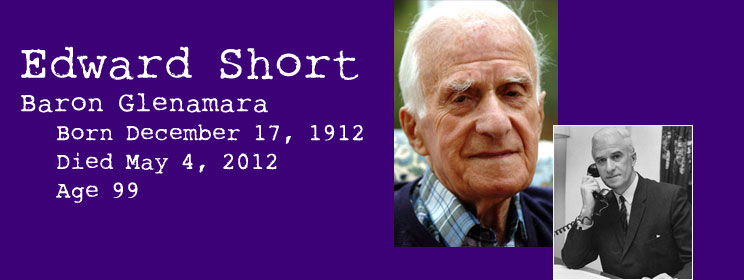 |
||||||||||||||
How are things in Glenamara? Boring. As relates to Baron, Edward Short. Or maybe he was Lord. In any case, he was a Labour Party functionary for about a thousand years. The son of a draper, he became a teacher, and diligently served in the Second World War as a captain in the Durham Light Infantry and then, after being demobbed, proceeded to write a history of the Durham Light Infantry. During his years as a teacher, he became the leader of the Labour Group on Newcastle-upon-Tyne and entered Parliament in 1951. Stuff went on and, in 1964, Labour won and Short became chief whip, and all that that means. I certainly don't. He was apparently quite busy and quite loyal, a little dim, very efficient, and good with scheduling. But then a really interesting part of his life arrives, as postmaster general. From the Guardian obit: "Unlicensed radio ships broadcasting pop music, led by Radio Caroline, were an irresistible force at the time. Short became a figure of fun among pirate radio fans when the Marine Broadcasting Offences Act, for which he was responsible, was passed in 1967. However, in a later interview he admitted that he actually liked pop music, which the BBC provided more of when it started Radio 1 in September that year." He lived to 99, so it goes on and on. His life and career, that is. In the realm of postage, he commissioned stamps from some interesting artists. He was Education Secretary, and had all kinds of really scintillating ideas. He was once accused of stealing money and putting it into a Swiss bank account, but it was dismissed because he was too f'in honest and too stupid to have done that. Turned out to be a forgery. He was a good soldier, and all those leaders depended on him to carry things through. His memoirs were called I Knew My Place. (I kid you not.) He then wrote From Whip to Wilson: The Crucial Years of Labour Government. In his final cabinet post, as leader of the Commons, Short achieved the immortality of having his name preserved in the phrase "Short money" — the statutory provision of funds for opposition parties. He still lived another twenty years, boring himself to death, no doubt. Drunkasaskunk gets 7 points, because Short died 7 months before his 100th. Figures. Couldn't even manage a centenary while alive. — Amelia |
||||||||||||||
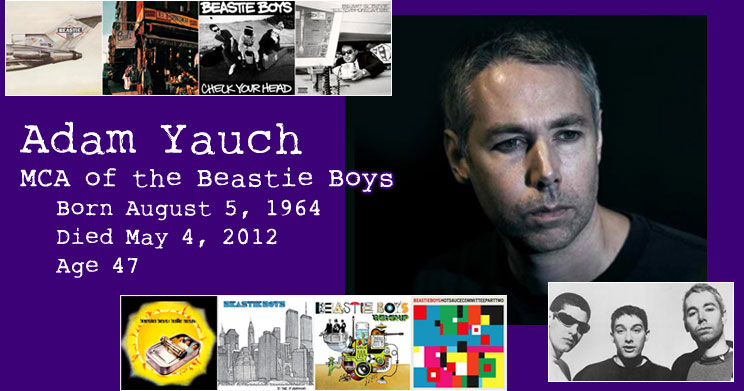 |
||||||||||||||
I love Fireball. This is why. It's got everything in it. What an amazing writer is Fireball. Although I didn't know he had five sons. * * * The Beastie Boys are the greatest white rappers of all time. Coming from me, that's not saying much. If you've known me for any length of time, then you know that I enjoy white boy rap about as much as I enjoy the thought of my five sons being anally raped by a Catholic priest. If it were up to me, white boy rap would've died a quick painful death years ago. Vanilla Ice, Insane Clown Posse, Snow, Paul Wall, Bubba Sparxxx, Asher Roth, Yelawolf, French Montana, Machine Gun Kelly ... they should all be put on a giant tour bus driven by Justin Bieber and sent off the North Rim of the Grand Canyon. Then there's Eminem: everything normal people have hated about the state of rap music over the past 15 years, all rolled into one psychologically disturbing package. He should be given the Rasputin treatment (poisoned, shot, strangled, beaten, "Bobbitted," bound, drowned, and burned) and then the Cromwell treatment (corpse exhumed, hanged and beheaded) for the devolution of rap music. But, to be fair, I don't want to put every white rapper and pseudo-rapper on that tour bus of death. I want to keep Weird Al Yankovic around because he's a musical and comedic genius. Mark Wahlberg redeemed himself by becoming a successful actor and producer. And B-Real of Cypress Hill knows where in the world we can find the best kush. Besides, every rap fan needs to smoke a blunt to "Insane in the Brain" at least once in his life. And then there are the godfathers of white boy rap, the Beastie Boys. I've never owned a Beastie Boys album, nor have I ever really liked the Beastie Boys ... but I suppose if anybody is gonna be called "the greatest white rappers of all time," it should be Mike Diamond, Adam Horovitz and Adam Yauch. Yauch was born in Brooklyn to a Catholic father and a Jewish mother. (White and Jewish? Wow, he couldn't have been more out-of-place in the rap industry if he'd been one of the meat puppets on FAUX News.) While attending Edward R. Murrow High School, he formed the Beastie Boys — then a hardcore punk rock band — with Diamond, John Berry, and future Luscious Jackson drummer Kate Schellenbach. By 1985, Berry and Schellenbach quit, Horovitz and deejay Michael Schwartz joined, and the band went from hardcore punk to a fusion of stereotypical 1980s rock and that newfangled thing called rap music. Rick Rubin liked what he heard and he signed them to his new record label, Def Jam. From then on, Yauch, Diamond, Horovitz, and Schwartz became known as MCA, Mike D, Ad-Rock, and Mix Master Mike. Their debut album, "Licensed to Ill," was released in 1986. It became the first rap album to reach #1 on the Billboard 200 Albums chart and would eventually become one of only a handful of rap albums to sell more than 10 million copies worldwide. (You remember albums, don't you? A collection of songs recorded onto a large vinyl disc, a small plastic disc, or a cassette? And you had to drive to a special kind of music store to buy one? And you had to buy one using a collection of green pieces of paper with pictures of dead white guys? Okay, perhaps I'm dating myself in front of all of you whippersnappers with your iPod Nanos.) Among other tracks, this album featured the group's signature song, "(You Gotta) Fight for Your Right (To Party)." It peaked at #7 on the Billboard Hot 100 and its music video was in heavy rotation on MTV. (You remember music videos, don't you? A short movie or collection of images set to a song from one of these aforementioned albums? And there were cable channels that would play these short movies 24 hours a day? Yeah, now I'm really dating myself.) Anyway, that video featured appearances by Rubin and a then-unknown rapper named LL Cool J. It was also one of the few Beastie videos not directed by MCA. He always directed under the pseudonym "Nathaniel Hornblower" (which, incidentally, is the nickname I give to any fucktard who sucks Eminem's dick). After some bad blood with Def Jam in 1988, the Beasties went to Columbia. Their next two albums — "Paul's Boutique" (1989) and "Check Your Head" (1992) — failed to replicate the commercial success of "Licensed to Ill," but the impact of these two albums is still being felt today. Extensive use of sampling and multi-layering (such as on "Paul's Boutique") is now commonplace in hip hop, and the harder sound of "Check Your Head" was responsible for the creation of the genre of music called "nu metal," thus paving the way for rap/rock bands such as Linkin Park, Korn, Slipknot and Limp Bizkit. (An entire genre that should also be on that Bieber bus to the Grand Canyon. Why, Beasties?! Why did you beget this genre of audio torture?!) The Beasties were back on top of the charts with "Ill Communication" (1994) and "Hello Nasty" (1997). "Sabotage" and "Intergalactic" were memorable songs, and those two music videos were in heavy rotation on MTV. Of course, in 1997, "heavy rotation on MTV" meant "MTV actually bothered to air the video." "Hello Nasty" went on to win two Grammys and two MTV Video Music Awards. "To the Boroughs" (2004) was the group's final album to hit #1, and "Ch-Check It Out" was the group's final notable song — not because it was on the radio a lot, but because it appeared on an episode of The O.C., a TV series about Orange County, which is undoubtedly the whitest part of Los Angeles Metro. The group's final music video, "Make Some Noise," was a Video of the Year nominee at last year's VMAs (and really, at this point, it is extremely hypocritical for MTV to continue to hand out awards for music videos when I haven't actually seen a music video on MTV since ... well, "Intergalactic"). Besides music videos, MCA directed his group's 2006 concert film, "Awesome: I Fuckin' Shot That!" Two years later, he directed something completely different: a sports documentary. "Gunnin' for That #1 Spot" followed eight of the best high school basketball players of 2006-07 in their quest for the coveted title of #1 pick in the NBA draft, alongside such hugely successful #1 draft picks as Andrea Bargnani and Michael Olowokandi. None of the eight players featured was drafted #1, although one player got close. The most famous of the group, Michael Beasley, was the #2 pick in the 2008 draft. His impressive rookie and sophomore seasons with the Miami Heat have made him one of the league's rising young stars. Despite his success, the Heat shipped him off to Minnesota in 2010 so that they could make room for LeBron James, a habitual crybaby who couldn't win an important game in Cleveland if his life depended on it so he turned his back on the citizens who made him who he is and ran to a team where he thought he could get an easy championship ring, and Chris Bosh, a guy who has looked like a Detroit crack whore with AIDS ever since he cut off his dreadlocks. (Are those ad hominem attacks against James and Bosh? You're goddamn right they are, and I dare one of you to prove to me that I'm wrong. But I digress ... ) Though the Beasties were famous for being Jewish, MCA became a Buddhist later in life. He spoke out for Tibet's independence, he created the Milarepa Fund for Tibet's independence, he formed several concerts for Tibet's independence, and he lost his own independence when he married a Tibetan woman. He was Richard Gere without the gerbil. In 2009, MCA got a license to ill... but it wasn't the good kind of ill. He announced that he had a cancerous parotid gland and a lymph node, and underwent surgery and radiation therapy. Last year, he accepted the VMA for his directing of "Make Some Noise" ... but, sadly, he wasn't present a few weeks ago for the crowning moment of his career: induction into the Rock and Roll Hall of Fame. For three years, he bravely fought for his right to live. He called his cancer "very treatable," which was probably why he was moved right to the top of Allezblancs' 2012 AODP list. He was the only deadpooler to predict that the rapper who gave us "No Sleep Til Brooklyn" would be in Brooklyn sleeping by the end of this year, so he gets 23 points and a brass monkey for his solo. —Fireball |
||||||||||||||
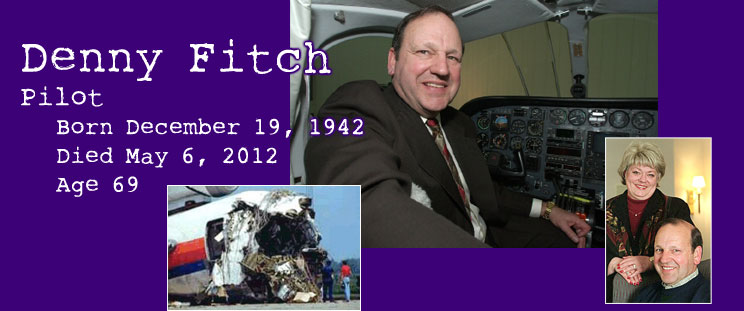 |
||||||||||||||
Wendy wrote to us and wanted to know how she could help. I figured she'd do one, but she surprised me and volunteered for three — this one, Abdelbaset al-Megrahi and Jonathan Frid. Each better than the next. (Thanks, W. Maybe this generosity will turn your luck around.) * * * A DC-10 has three hydraulics systems controlling its flight direction and altitude. The odds of all three failing at once is the proverbial "one in a billion," so unlikely that no airline had a procedure for that catastrophe. Add to that computation the need for a flight instructor who specializes in hydraulic emergencies, and the odds become improbably teensy. Except that it happened exactly that way. On July 19, 1989 Captain Denny Fitch, a United Airlines captain and flight instructor, was deadheading home on United Flight 232. When the DC-10's aft engine exploded over Iowa, Fitch went to the cabin to offer his assistance and found the blast had destroyed the jet's hydraulics. Fitch worked with Captain Al Haynes and his crew to find a way to steer the jet without flight controls. By varying the power of the two wing engines, they managed a slow right-hand spiral turn that got the jet lined up with the runway at the Sioux City airport. On landing, the right wing dug into the runway and the jet broke apart; 111 people died while 185 survived. That forty minutes is said to be the longest time aloft without flight controls — with the crew surviving, that is. No one has improved upon Haynes and Fitch's efforts in simulations of UA232's flight. In 2003, a DHL Airbus A300 was struck by a surface-to-air missile after taking off from Baghdad International, causing the loss of its hydraulics systems. The crew used Haynes and Fitch's method of power control to return to the airport, the only reported time a commercial aircraft landed safely with no flight controls. Denny Fitch returned to his job as a United captain and flight instructor after he recovered from his injuries. He served on the Aerospace Safety Advisory Panel and was inducted into the Aviation Hall of Fame at the Smithsonian. He was diagnosed in 2011 with glioblastoma (a type of brain tumor) and he died on May 7, 2012. The Oscar-winning filmmaker Errol Morris did a short film on Denny Fitch that's worth watching on YouTube. It's an installment of Morris' TV series of a decade ago, First Person. — Wendy
|
||||||||||||||
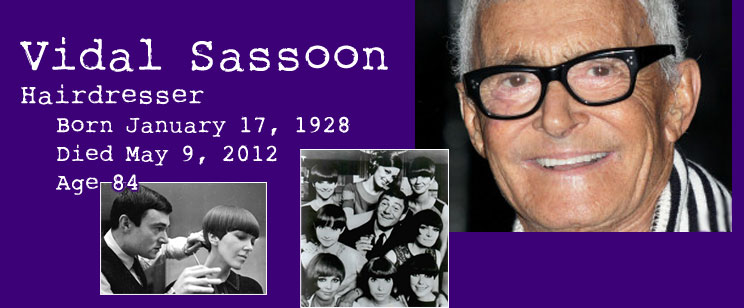 |
||||||||||||||
I believe Charlene has always nailed her exquisite updates in three paragraphs or fewer. A pleasure, as always. * * * Vidal Sassoon was fortunate that his professional peak coincided with the first generation of young women both wealthy enough to afford his services and independent enough not to worry about what Mommy would think. He was the king of the haircut: Eschewing the teasing and curling and lacquering and all that Aquanet-infused fakery of the Fifties and Sixties, his style depended on scissors alone. As he said, "If I was going to be in hairdressing, I wanted to change things. I wanted to eliminate the superfluous and get down to the basic angles of cut and shape." A young woman with a Sassoon haircut need only wash, dry and go: no elaborate styling was required to get the cut to look right. I stress "a young woman," for what made Sassoon a success with the 18-35 crowd failed with the over-40 crowd. As a woman ages, her hair becomes coarse and frizzy and loses its shine, and the "precision haircut" becomes anything but. And Sassoon knew that: He knew that eventually the teased, lacquered look would come back as his target market aged and needed more help to look young than a haircut could give, and he knew that the next generation would look to some new style icon. Sassoon didn't give up, though; he just contracted his business. The shampoo line went in 1983; the salons remained until 2003. But he still stuck to his own belief that all a woman needed was a good haircut and healthy hair, and why not? That belief had taken him from the slums of the East End to a life of fame, wealth and comfort. Vidal Sassoon died on May 9 at the age of 84. He probably isn't looking good right about now, but Mo's deadpool standings are, with five points for the solo plus five for age. Total: 10. — Charlene |
||||||||||||||
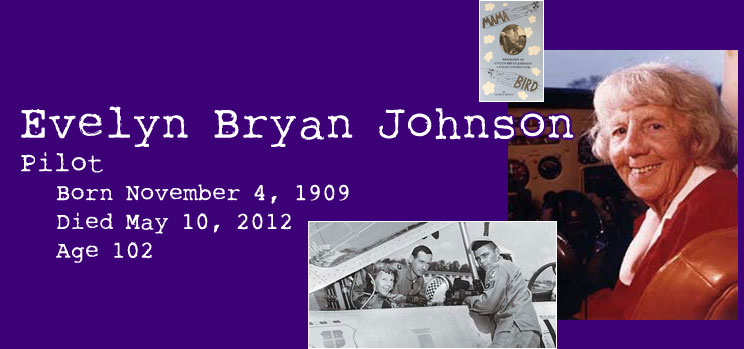 |
||||||||||||||
|
WEP got this marvelous hit and sent along a marvelous update, all the way from Germany, if his email address tells the tale. Danke schön. * * * Have you ever heard of Mama Bird? No, not the tall yellow singing one from Sesame Street. That's Big Bird. I mean the ancient, flying one from the Guinness Book ... Evelyn Bryan Johnson was working as a teacher before she met her first husband, W.J. Bryan, in 1944 and learned how to fly. This was the beginning of her career as a "flying Stone" — her maiden name. Johnson survived more than 57,000 hours in the sky, several accidents and two husbands to enter the Women in Aviation Pioneers Hall of Fame and the People Who Have Worked As a Teacher and Learned How to Fly Hall of Fame, etc. (They have halls like this everywhere.) Her final step was a title in this beer-book, which finds titles for everyone: She was named in the Guinness Book of World Records as the "female pilot with the most number of flying hours in the world," a title which becomes less impressive after you consider her age. And after receiving all these honors, medals, titles and subtitles, Johnson spent her last days on the list of "people I have never thought of still being alive" in the category of "people I never wasted a thought on before." And even someone who had her on his AO Deadpool list remained unmoved by her death, until remembering that there was "some bird on it" ... And this frail, one-legged, flying, title-snatching, forgotten lady from Tennessee now leaves the cockpit forever. Six points are her legacy: one for her age and five as a solo bonus for WEP, who now checks his list of names daily ... — WEP |
||||||||||||||
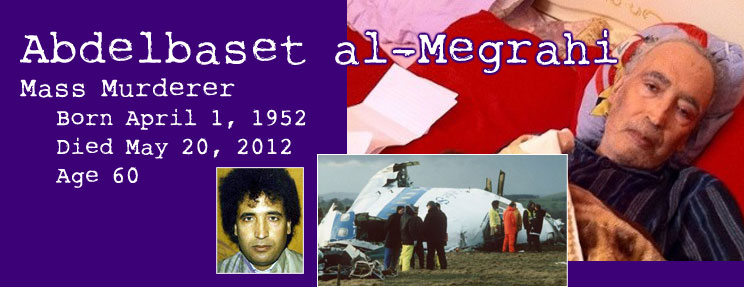 |
||||||||||||||
Wendy comes through with another writeup, and the staff at the AO Deadpool are extraordinarily grateful for her help. The following got 11 points each: Allen Kirshner, Allezblancs, Another Lurker, Bill Schenley, Buford, Charlene, DDT, Deceased Hose, Denise, DGH, Direcorbie, Drunkasaskunk, Ed V, Gerard Tierney, Hulka, JD, Loki, Mo, Morris the Cat and Worm Farmer. I wish one of them had been Wendy. * * * On December 21, 1988 at the Luqua Airport in Malta, a suitcase was placed on Air Malta's Flight KM180 to Frankfurt. There it was transferred to Pan Am 103, a flight terminating in New York City with a stop in London. The suitcase contained some clothing purchased in Malta, and a Toshiba "BomBeat" radio cassette player. The cassette player contained an IED made of Semtex and a timer identical to ones exclusively supplied to the Libyan government by MEMO, a Swiss company. It is thought the bomb was intended to explode over the Atlantic, but it detonated early over Lockerbie, Scotland. 270 people — passengers, crew and Lockerbie residents — died. These are facts. That Abdelbaset al-Megrahi, the chief of security for Libyan Arab Airlines, actually put the bomb in the suitcase and the suitcase on the airliner is based on circumstantial evidence: He was a Libyan intelligence officer involved with MEMO, he was identified as the purchaser of the clothing by the clothing shop's owner, and he was in Malta on December 21 under a false passport. Scottish judges decided this was sufficient to convict al-Megrahi of terrorism, the only person convicted in this bombing. Al-Megrahi never confessed. The Libyan government also maintained his innocence even as it accepted responsibility for the bombing. Intelligence officials noted that professionals in their field never admit guilt; they stick to the cover story, no matter what the outcome. Eight years into his life sentence, al-Megrahi was granted compassionate release and returned to Libya due to his advanced prostate cancer; it was said he would be dead in three months. Three years later, al-Megrahi finally succumbed to cancer in Tripoli. It's unknown whether he changed his story on his deathbed. — Wendy |
||||||||||||||
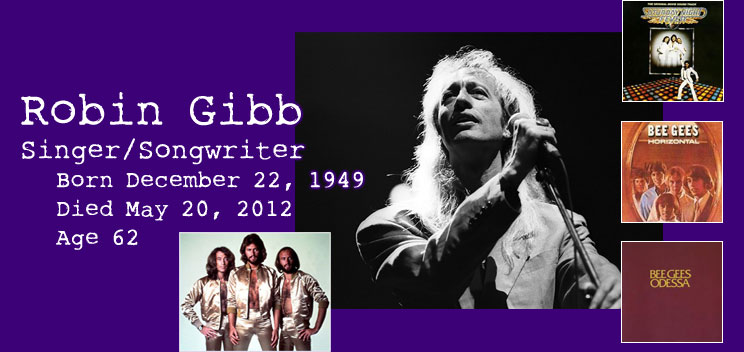 |
||||||||||||||
Jim Thornton wrote this for us, even though he was in the midst of his son's wedding. That's dedication. I've missed his poems! Thanks, Jim! These 31 people took one look at Robin's recent photos and shamelessly added him to their lists: Allen Kirshner, Allezblancs, Bill Schenley, Buford, Busgal, Constant Irritant, DDT, Deceased Hose, Denise, Dianagram, Direcorbie, Drunkasaskunk, Eternity Tours, Gerard Tierney, Grim McGraw, Happy No Year, HAWTHORN Tom, Hulka, Jason Smith, JD, Keister Button, Loki, Mark, Mo, Monarc, Morris the Cat, Ray Arthur, Sad Last Dave, The Wiz, Tim J. and Worm Farmer. 11 points each. * * * Now which Bee Gee was Robin? Toothy, big hair and falsetto? No, that was Barry, and he's still with us. Married Lulu and wore a hat to hide his baldness? No, Maurice died in 2003. Robin was the other bald one — terrible wigs and tinted specs. In their first period of success he was the voice of the Bee Gees. The one who sang the lead on "Massachusetts" and a dozen other late-sixties hits. He had hair, girls loved him, and a million guys got lucky. But the hits got smaller, his hair fell out, and Barry took a bigger role. Robin felt sidelined, and in the early seventies he tried to break up the band. Until Saturday Night Fever — sales never dried up after that. Rock stars came and went, but the Bee Gees went on and on. It was a long time in the public eye, and the brothers quarrelled endlessly with each other and with their managers — mainly over money. They had a lot of it. According to Wikipaedia only Elvis, the Beatles and Michael Jackson outsold them. Robin also dabbled in New Labour to the point where both Tony Blair and Gordon Brown claimed him as a friend. Quite an achievement! He married twice. His second wife Dwina, a painter, made him a vegan. Perhaps she thought it would prevent him getting the family disease of bowel cancer — red meat and all that — but he succumbed like his brother and three uncles, so maybe it was in the genes. Dwina was allegedly a bisexual druid priestess, and happy with an open marriage, which must have helped when towards the end of his life it emerged that he'd been having an affair with his housekeeper for a decade or so. Claire Yang was 26 years younger, and three years before his death had a daughter by him. That'll complicate the reading of the will. |
||||||||||||||
|
||||||||||||||
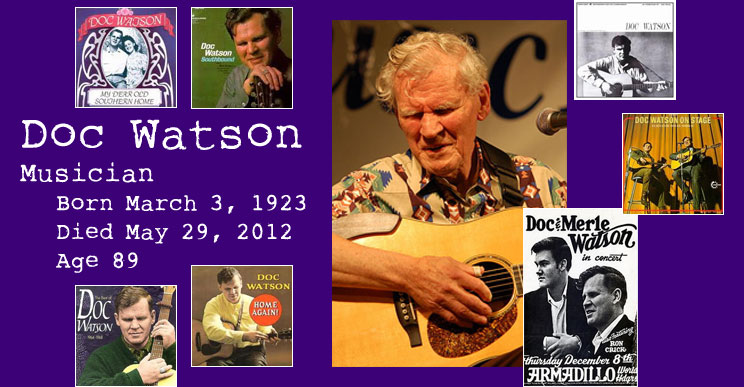 |
||||||||||||||
Busgal knows her music, and it shows. Thanks, Busgal! * * * In 2006 I went to my first major bluegrass festival, the River of Music Party (ROMP) in Owensboro, Kentucky. The one musical moment I remember was late Saturday night, hearing Doc Watson sing "Summertime." (I also met Doug Dillard, who died last month, too.) Arthel "Doc" Watson was about thirteen when he and his brother cleared out dead chestnut trees to earn the money for his first guitar, a Stella that Doc described as "one of those ten-dollar guitars." He would own many guitars throughout his life: a Sears Silvertone, a Martin D18 that he used on many of his earlier recordings, a Martin D-28 (his first Martin), his Gibson Les Paul, and his best-known guitar which was made for him by J.W. Gallagher — the G-50. One of his G-50s, Old Hoss, is in the Country Music Hall of Fame. His first stringed instrument, however, was a fretless banjo he learned to play at the age of six. Ten years later his father made him another banjo, using the skin of a cat that had just died for the banjo's head. Watson proved to be a natural musical talent and was soon performing on local street corners, playing songs from the Delmore Brothers, Louvin Brothers and Monroe Brothers alongside his own brother, Linny Watson. Doc's earliest music influences were Jimmie Rodgers and the Carter Family, and his biggest guitar influence was Django Reinhardt. By the time he was a young adult, Arthel was proficient on both acoustic and electric guitars. Married with two kids, Arthel joined a country 'n' swing band in 1953. Since they lacked a fiddler, Arthel adapted those licks (including "Beaumont Rag") to his Les Paul and then his acoustic guitar. One day on a radio program the DJ had trouble pronouncing "Arthel" and so he called him Doc. Around 1960 Doc joined the folk music scene upon the advice of musicologist Ralph Rinzler and went exclusively to acoustic guitar and banjo. Rave reviews came from the Newport Folk Festival in 1963. His fingerpicking style was good, but he's best known for his flatpicking bluegrass style and strong baritone voice. Doc's son Merle was with the act from 1964 until his death in 1985 in a tractor accident. To honor his memory, Doc started Merlefest in 1988. The festival drew 4,000 fans in the first year. It consisted of two stages set up on the backs of two flatbed trucks. Today Merlefest draws 45,000 bluegrass fans from across the globe. It spans a four-day period and boasts 13 stages. Doc received eight Grammys from 1973 through 1996, including a Lifetime Achievement Award in 1994. He received the National Medal of Arts in 1997 and was inducted into the Bluegrass Hall of Fame in 2000. In 2010 he received an honorary doctor of music degree from Berklee College of Music in Boston, Massachusetts. When Doc was born, he had a defect in the vessels that carry blood to the eyes. He later developed an eye infection that caused him to completely lose his vision before his first birthday. He was raised and resided in Deep Gap, North Carolina until his death. Busgal, Exuma, Hulka and johnnyb all get five points for attending the final concert of one of the greatest flatpickers ever. Total: 5. — Busgal |
||||||||||||||
